KCQ rides early-20th-century interurban railways to find memories, mayhem and maps
“What’s your KC Q” is a joint project of the Kansas City Public Library and The Kansas City Star. Readers submit questions, the public votes on which questions to answer, and our team of librarians and reporters dig deep to uncover the answers.
Have a question you want to ask? Submit it now »
By Dan Kelly | Kansas City Star
Perhaps the best way to tell the 40-year story of Kansas City’s interurban railways is to start at the end of the line.
On July 9, 1940, the final day of the Strang Line interurban’s passenger service, the last run evolved into a riot on the rails.
Early in evening, a souvenir-seeking passenger had tried to abscond with a seat cushion by throwing it out a window and getting off at the next stop to retrieve it. Motorman Jimmy Collins would have none of it. “One of those souvenir guys, huh? Well, I’ll take that cushion if you don’t mind.”
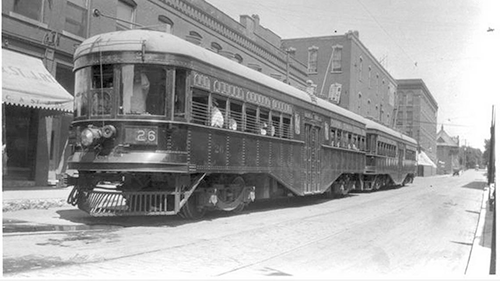
Springs is shown sitting at 13th and Walnut in about 1915. | The Kansas City Public Library
Hours later, a red Strang Line car, with 82 passengers crammed into 55 seats, departed from Ninth and Main streets in downtown Kansas City en route to Olathe for what was supposed to be the start of the line’s last-ever round trip. By the time the car arrived in Olathe, riders had broken windows, torn up seats and destroyed fixtures.
It was so bad that police boarded the railway car at 19th and Main to tell passengers to quiet down. Then Thomas “Cap” Riley, who had been a key figure for the Strang Line since its inception in 1906, canceled the final return trip to downtown.
That riotous run in 1940 was the swan song for the wide-ranging and somewhat perilous interurban system in Kansas City, all other area lines having already folded. Remnants of the interurbans’ heyday dot the local landscape, but their origins likely are a mystery to most people.
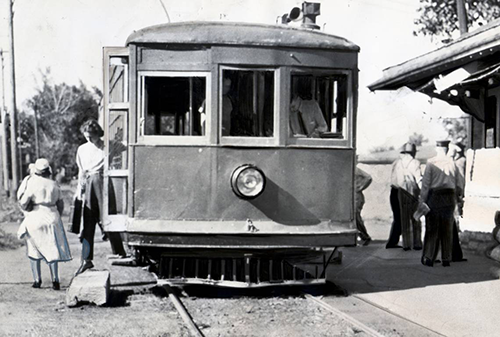
the last day of the line’s operation and of Kansas City’s interurban system. | File Photo
Reader Margie Timmons-Maasen wanted to know more. Her query to “What’s Your KCQ?,” The Star’s ongoing series with the Kansas City Public Library that answers readers’ questions about our region:
Please tell me all about the interurban railroad running up into Platte County and on to St Jo. The Winnwood route went on to Excelsior didn’t it?
In a follow-up email, she said, “I bet younger people in KC, especially where the Interurban ran, would be shocked to learn a high-speed electric train ran from downtown — up north of the river in two areas … in the early 1900s! An early ‘commuter’ rail?”
The interurbans — so named because, unlike city streetcars, they carried passenger beyond urban areas — had cheaper fares than regular railroads with more frequent runs, and they almost always operated on electricity rather than coal.
The line to which Timmons-Maasen referred, the Kansas City, Clay County & St. Joseph Railway, operated routes to St. Joseph and Excelsior Springs. But, as the tale of the Strang Line’s demise illustrates, there was much more to Kansas City’s interurbans.
They transported people to and from dozens of destinations. In fact, as we celebrate the expansion of our city’s 21st century streetcar line to nearly six miles — woo-hoo — it’s worth noting that the area’s independently operated, non-taxpayer-supported interurbans rode at least 200 miles of rails.
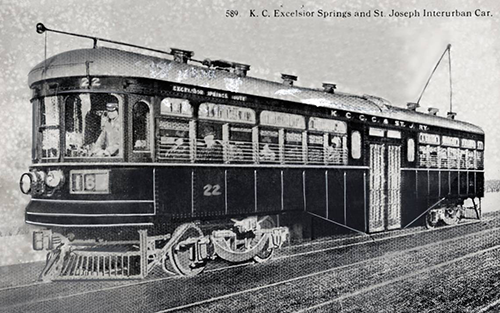
Time traveling
The Kansas City, Clay County & St. Joseph, better known as the KCCC&SJ, was generally considered the crown jewel of the local interurbans. With two separate lines, it also was the longest.
But it wasn’t the first.
That was the Kansas City, Leavenworth & Western, which made a trial run on Jan. 13, 1900, and began regular traffic a few days later. It joined a nationwide wave of interurban lines that had begun in the 1890s.
Of course, that’s merely when the term “interurban” came into wide use. It could be argued that the first interurbans actually were horse-drawn operations, including the Kansas City and Westport. Completed in 1871, it traveled through four miles of rural area from Fourth and Main to the far-off environs of what is now 39th and Main. But that’s a story for another day.
By 1914, the area boasted eight interurbans operating 297 cars a day, according to a June 6, 1970, story in The Star. Some lines evidently operated only briefly because other histories place the number at five or six.
“A Splendid Ride: The Streetcars of Kansas City 1870-1957,” by former Star editor Monroe Dodd, discusses five interurban lines. In addition to the KCCC&SJ, the Kansas City, Leavenworth & Western and the Strang Line (officially the Missouri & Kansas Interurban Railway), there were the Kansas City, Lawrence & Topeka (known as the Hocker Line, it never reached Lawrence or Topeka) and the Kansas City, Kaw Valley & Western (it ran to Lawrence).
The interurbans, rolling beneath a single wire strung above the tracks, were typically single cars (the KCCC&SJ line, which carried thousands of people each weekend to Winnwood Beach in Clay County, sometimes had multiple cars linked together). They used the same basic technology as trolleys and streetcars in the cities, but the cars were larger, faster and featured more creature comforts. “A Splendid Ride” indicated one-way fares ranged from 25 cents to $1.55.
Walter Deitchman, who had been a regular on the KCCC&SJ, told The Star in 1996: “That line was so popular, sometimes you had to fight to get a seat. But it was worth it. … It was a thrill to ride.”
The 82-year-old also discussed the interurbans’ speed, which appears to have been a point of contention.
“Nowadays they talk about building a 60-mile-an-hour light rail line to the airport, and they think that’s fast,” Deitchman said. “Well, that was just cruising speed for the interurban trolleys.”
That 1996 story said the KCCC&SJ’s express car “often topped 80 mph and sometimes hit 100.” Most other sources indicate the interurbans’ top speed was more like 70 mph with cruising speeds of 30-40 mph, still faster than the popular Ford Model T of the day. Of course, the interurbans went much slower in towns and cities.
Connecting populated areas wasn’t the only the reason for the lines. They also made suburban areas more attractive to development. The KCCC&SJ is credited (along with the opening of the ASB Bridge in 1911) with much of the growth north of the Missouri River, and the Strang Line essentially created Overland Park.
In fact, William B. Strang Jr. is considered the founder of Overland Park. He designed the Strang Line (with no bridges or culverts) to pass his real estate developments, among them Overland Park. He also built an aviation park at the end of the line that drew thousands to see the new-fangled flying contraptions in the years before World War I.
“There were only two houses in Overland Park when we built that line out there,” said Riley, who was Strang’s right-hand man and then his successor.
For many rural residents, the interurban was a lifeline to the big city.
In 2002, Delbert Crabtree of Platte City related memories more than 80 years old to The Star.
“I’d ride into Kansas City at Eighth and Grand where they had those nickel hamburgers, and I could eat three or four of them,” he said. “Up on the corner, they had a drugstore with 11-cent cigarettes.”
Crabtree, then 94, also described how folks in the KCCC&SJ’s early days drove buggies to the Sharp’s Station store, where they hitched them in back of the store.
“Then they’d get on the interurban and go to town and do their shopping,” he said. “Sometimes you’d get up in the morning, and there would still be an old horse tied there. They’d missed the last train out at night.”
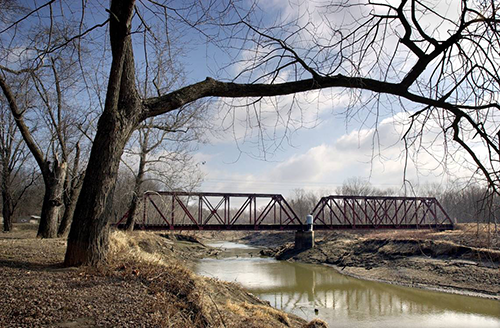
starting in 1913 and later carried one lane of traffic on Interurban Road. It was replaced
by a two-lane bridge in 2003. | Keith Myers, The Kansas City Star
Danger zone
As alluring as a tranquil trip through the countryside sounds, the interurbans also produced a good deal of congestion — to say nothing of carnage.
After the KCCC&SJ began operating into and out of downtown Kansas City, where multiple lines used the same tracks, The Star reported on May 16, 1913, that mayhem ensued, with long delays and near accidents.
“With the 17 St. Joseph trolley cars added to the other 34 interurban cars and seven Metropolitan lines, all of which stop or turn at 13th and Walnut streets, that narrow crossing was almost a continual blockade yesterday.”
The situation was even more dangerous elsewhere on the interurban lines.
Livestock were at particular risk, but humans were frequent victims as well. That’s not surprising given the rudimentary railroad crossing warning systems of the day and the lack of any centralized railway traffic control system.
The KCCC&SJ distributed greeting cards to customers in 1915 listing its safety statistics and boasting that of more than a million passengers that year only nine were injured. Of course, those statistics didn’t account for non-passenger injuries and deaths resulting from accidents — the greeting cards noted there were 13 collisions with livestock and 23 with automobiles and other vehicles.
That was a supposedly safe year. For just one interurban line.
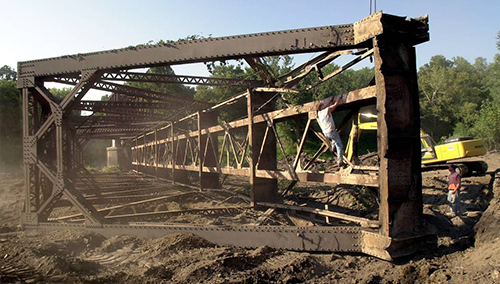
make way for a new concrete span over the Platte River. | The Kansas City Star
A few calamities of the interurban:
- Jan. 11, 1912: Two Kansas City, Leavenworth & Western interurbans collided head on in fog south of Wolcott. Five people died.
- April 29, 1918: A 22-month-old girl was struck and killed by a KCCC&SJ car near Excelsior Springs. The Missouri Supreme Court awarded the parents $10,000 in March 1922.
- June 14, 1919: A trolley rammed into the rear of a stopped Kansas City, Kaw Valley & Western interurban car on the Inter-City Viaduct, severing both legs of a 15-year-old boy on the trolley and injuring several others. The boy later died.
- March 11, 1920: Two were killed and 13 injured when a Kansas City, Kaw Valley & Western interurban car crashed into a steel sand car (freight train) on a rainy, windy night.
- April 27, 1930: Downtown Kansas City was jammed with shoppers when the brakes failed on an eastbound Kansas City, Kaw Valley & Western car. It jumped the track and careened down a sidewalk, scattering pedestrians. One man panicked and tried to outrun the car. He was the only fatality.
- Aug. 31, 1935: An automobile skidded on slippery tracks in Leavenworth, crashed head on into an interurban car and caught fire. Four people in the car died.
- Dec. 23, 1936: A 48-year-old man was lying on a rail in downtown Kansas City, Kansas, when he was struck by a Kansas City, Leavenworth & Western car. He was decapitated.
- Aug. 20, 1937: Flood waters from a sudden downpour swept a Leavenworth car carrying nine passengers off a trestle crossing Maltby Creek and carried it downstream. It slammed into the creek bank and turned over. Motorman Fred Davis saved the day when he grabbed a rope and lassoed a tree stump to secure the car and prevent it from floating further downstream to the Missouri River. There were no significant injuries.
Then there were the many fires and robberies (after one, the culprits were found with $587, mostly in nickels, dimes and quarters).
One notable fire, caused by a short circuit on May 17, 1939, left a Strange Line car spewing flames in downtown Kansas City. Passenger Lula Zeiger of Hardy, Arkansas, told The Star: “I don’t know whether I like these big city things or not. Nothing like this ever happened to me down in Hardy.”
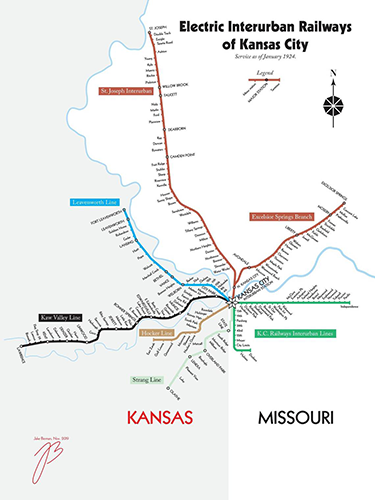
, a commercial contract lawyer from New York. It includes Kansas City Railways’ routes to Independence and Dodson,
which some considered streetcar lines. | Courtesy of Jake Berman
How much could a 35-year-old commercial contract lawyer from New York possibly know about the Kansas City area’s interurban rail system of nearly 100 years ago?
Quite a bit, as it turns out.
Jake Berman’s hobby is designing maps of big-city rail, streetcar, subway and interurban systems (along with diagram art relating to “Star Wars,” “Lord of the Rings,” Pokemon and more), which he sells at his Fifty-Three Studio website. He plans to turn the maps into a book called “The Lost Subways of North America.”
They include most major U.S. cities, with Kansas City being one of his more recent works.
“My grandmother is a proud alum of KU and KU Med School way back in the Stone Age,” Berman said. “So she would have taken the interurban from Lawrence to KC, for instance. … So Kansas City, it’s my grandmother’s connection.”
Berman’s Kansas City map highlights the interurban system as it existed in 1924, with six lines: the five covered in “A Splendid Ride” and two combined Kansas City Railways routes to Independence and to now-defunct Dodson.
KC Railways was the city’s streetcar company, so the Independence and Dodson lines could be considered part of the city’s streetcar system. The Dodson line, which went beyond the city limits to about 85th and Prospect, sparked the growth of Waldo and beyond and continued as a streetcar line until the 1950s.
“It took, I want to say, about two months to put this together because what I was trying to do was assemble all these things from original sources,” Berman said. “So all of the stuff was put together based on the original timetables.”
Berman said sales of the 18-by-24-inch Kansas City interurban poster have been “OK. It’s been beer money, put it that way.”
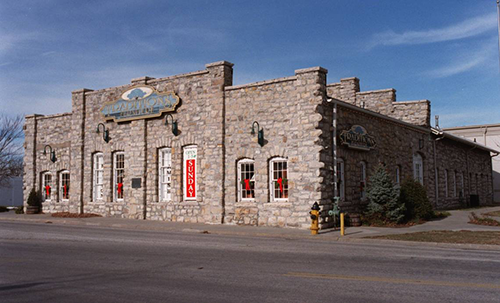
The building served as the car barn for the Strang Line. | Jeff Roberson, The Kansas City Star
Remnants and memories
When Kansas City International Airport was in its planning stages and infancy, there was talk of a rapid-transit system from there to downtown that would follow part of the railbed of the old KCCC&SJ.
The new rapid-transit system turned out to be a pipe dream, but the railbed hasn’t gone anywhere.
Interurban Road traces part of that route in Platte County and is one of many reminders of the area’s interurban system. Other streets recalling the lines include Strang Line Road and Hocker Drive in Johnson County.
Remnants of abandoned interurban railbed are scattered about, some of which have been converted to hiking/walking trails such as the Line Creek Trail in Platte County and the Interurban Trail in Riverside.
A few old bridges also have survived in the Northland, including one at the Martha-Lafite Thompson Nature Sanctuary in Liberty and another just north of Avondale.
Buildings that housed interurban stations also exist, notably in Overland Park, where the former Strang Line depot at 80th Street and Santa Fe housed a home-decorating store for decades before the Overland Park Historical Society took it over in 2019. Downtown Overland Park also is the site of the Strang Line’s old car barn (now a furniture store). Nearby stands a statue of Strang.
Riley, the former Strang Line executive, probably wouldn’t recognize the place. He spoke to The Star as a 91-year-old in 1960, describing how the Strang Line was popular with farm youths commuting to their jobs and housewives going shopping, as well as tipplers traveling from the dry state of Kansas to obtain liquid refreshments in Missouri.
“Those were wonderful days, but you had to keep going,” he said. “After daylight was no time to sleep.”
Just as Riley had been on hand for the beginning and end of the Strang Line, S.E. Peck had witnessed the start and finish of the Kansas City, Leavenworth & Western. He watched one of the final cars roll past his filling station in Bethel the day the line ceased operations in April 1938.
“I saw the first one leave,” Peck, 82, told The Star at the time. “It’s like the passing of an old friend to me. When I came here in ’72, there were Indians camped hereabouts, and the thought of a trip to Leavenworth in an hour and a half was as fantastic as the plan for one-day service to Europe now.”
Submit a Question
Do you want to ask a question for a future voting round? Kansas City Star reporters and Kansas City Public Library researchers will investigate the question and explain how we got the answer. Enter it below to get started.
